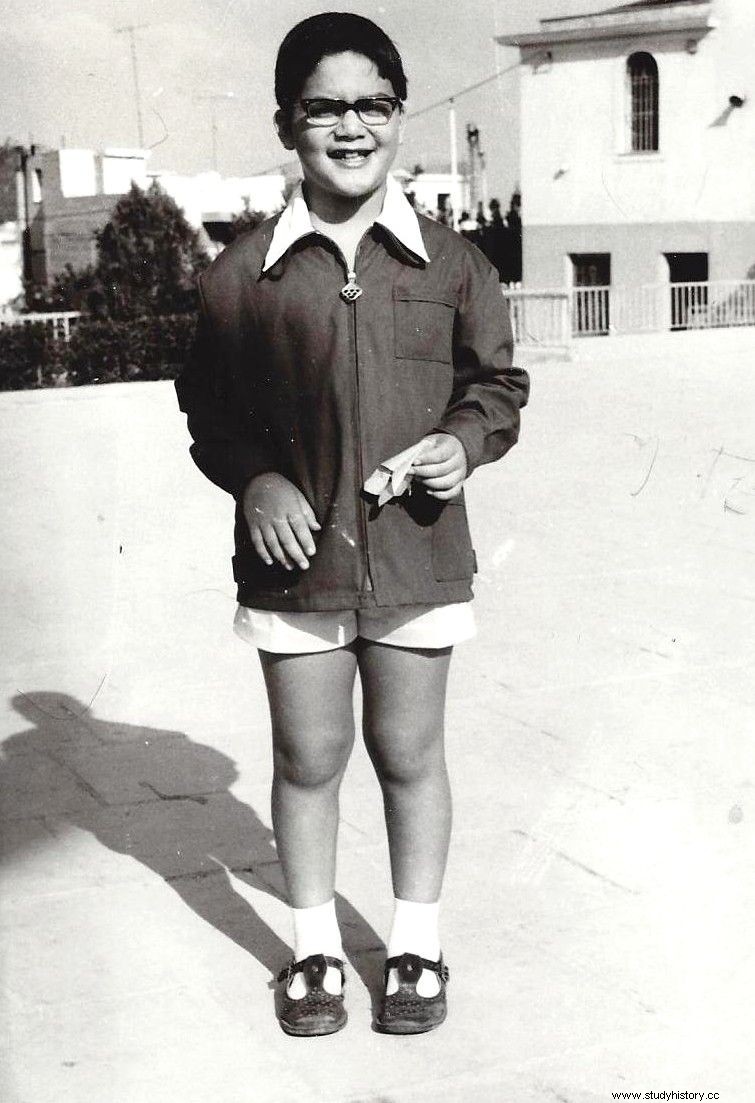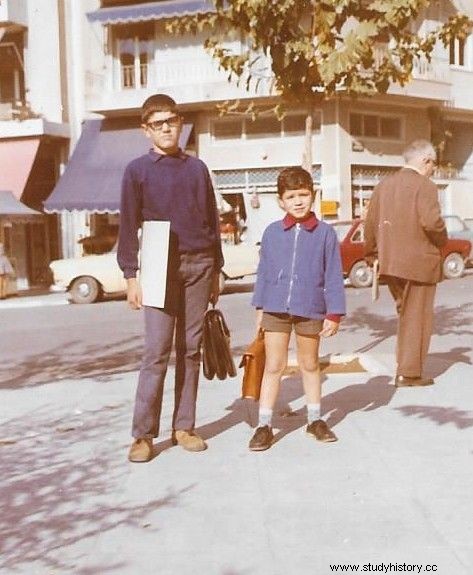40 years ago, Lefteris Beryvakis put his signature on the circular which permanently abolished school aprons. The first Minister of Education of PASOK, once a partner of Alekos Panagoulis in the attempt against the dictator Papadopoulos and sentenced to life by the junta, put an end to the compulsory clothing of girls who went to school. They were now free to wear whatever they wanted. And elementary school boys, too
It was the time when I was living (with) cosmogenic changes in education, we the students, but also the teachers together with our parents. It's been so many years, I honestly didn't remember that in those early years of the 80s, it all came together, we didn't have time to get used to one and the other happened to us.

The apron was the last chapter, in a stream of constant changes, which made the school less rigid, certainly more modern, as we slowly, albeit with obstacles, left behind decades of anchorages and an unrestrained conservatism. With hands outstretched to be struck by the teacher's ruler (or worse, the teacher's), with hair loss and invisible fear.
The ND government was more hesitant, PASOK's first was furious, they were changing our daily life
1979 is the last year that the students of the sixth high school took the entrance exams in September with all the material they had been taught all the years and after studying all summer I don't know what (not even my brother, who passed the Polytechnic, remembers).
A year later the students of the 2nd and 3rd Lyceum, as they were now renamed after the institutional "split" of the Gymnasium, took pan-Hellenic exams on a specific subject. In October 1981, at the last pre-election meeting of PASOK at the Syntagma, Andreas Papandreou announced the abolition of the exams at the B Lyceum (leaving them exclusively for the last year) amid celebrations of the young students present who were waiting to hear the verdict promise (true fact).
In the battle for the 1981 elections, the Ralli Government established the five-day working day in the public sector, which, after a major teachers' strike, was also implemented (from February 1981) in schools. Suddenly Saturday was ... ours. Consider that many times we had class on a Saturday afternoon and went to school on Monday morning, I'm getting depressed just writing this. By the way, we did not spare the morning-afternoon, since the Gymnasium was also housed in the same building, the time was necessarily divided between the two...
In January 1982, of course, the monotonic system was established. They are thin, dense, fragmented, the rules are long before short etc, etc, the doubt about dense or thin with the intermediate curve that looked like both. No, our language did not change, nor did we learn worse Greek, nor was the world destroyed, as the proponents of polytonicity believed and risked. Some, four decades later, are still grumbling to a graphic degree.
At the same time, boys' and girls' schools began to become mixed. Boys and girls together, although our own class in 17th Lyceum kept the "male" tradition until the end (cry).
But as girls and boys studied together, the abolition of the blue apron was expected. And it came true on February 6 of the saving year 1982.
The appearance of the students was a topic that even occupied Ioannis Kapodistrias. The first governor of the country set in writing the clothing conditions (and also punishments if they were not observed) for young Greek boys. Dozens of circulars aimed at decent clothing at school in one of the poorest countries in Europe, became a headache for parents and students, especially those who did not have money, but were thirsty for knowledge.

Except knowledge wasn't for everyone. Girls, after all, didn't even go to school and those families who had the luxury of urban propriety dictated their education, inside the home. Later, when the girls reluctantly started going to school too, the dark-colored apron with a white collar became their permanent attire. As for the boys, the necessary accessory that reminded everyone that these are students was the quotient with the owl. Real army...
In 1964, George Papandreou declares that the pelikio is now only worn in the province and, wanting to equalize the students of all Greece, he abolishes it entirely. A year later the apron becomes compulsory for everyone in primary school and for girls in secondary school.
It is now blue in color to remind us of the sky and the sea of the homeland, the collar remains white (it was added so that it can be detached and cleaned easily), while for the girls the sosonaki are also added. Of course the length was below the knee. On the lapel of the apron, each student has the emblem (badge, or sewn) of the school and the class they attend.
The junta that follows surpasses in arteriosclerosis what had preceded it. Restrictive regulations become almost gospel, since teachers, even if they want to turn a blind eye, have the superintendent's sword of Damocles over them. That is, the watchful eye of the regime that oversees the Greek-Christian education of young and old.
The apron must be well ironed, it doesn't matter if the student is stacked with 50-60 others in the same class, as long as he takes care of his appearance, headdress and attire.

It remained, of course, a trademark of the girls who went to Girls' Gymnasiums. The boys, after graduating from elementary school, could dress decently, in whatever they wanted. The girls don't. They say that the apron, the uniform dress, prevented the distinction between rich and poor. Not exactly. Although the aprons were all the same color, the eye could easily distinguish which were cheap and which were expensive.
The collaboration of Yiannis Tseklenis with "Minions" towards the end of the 70s makes the apron a fashion issue. An apron with the signature of the Greek dressmaker costs even 1,750 drachmas, twice the price of the others ... without the brand and the glamor of Cheklenis.
The fire in the department store in 1980 combined with the abolition of the apron, financially destroys the famous dressmaker, since the purchase of 350,000 meters of fabric remains unused. Just before their abolition, the expensive and elegant aprons cost up to 4,000 drachmas. Others take up the baton and the "Aegeon" company finds Mariana Toli, a central figure in advertising and on television (titterititi Aegeon...)
The length of the apron for girls was a key issue, especially at the time when the mini had made a real revolution in women's clothing.
The schoolgirls at that time still remember various tricks with the belt, which shortened the aprons above the knee (when, of course, they were outside the school) but also the teachers who measured with their ... palms if they were the normal length!
Later, mainly in schools in Athens, some schoolgirls with a playful spirit, wore a blue blouse and skirt replacing the aprons, under the tolerance of course of the high school principals. If they fell into a crooked tree, they would go back to the established ones. Those who wanted to have fun, took their normal clothes with them.
Towards the end a blouse over the apron was a given, the uniformity began to break, already girls and boys went to school together and in a time of rapid change the blue apron was permanently put in the closet.
